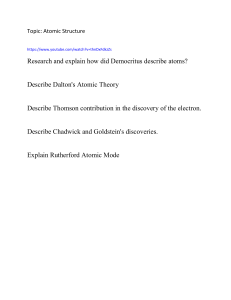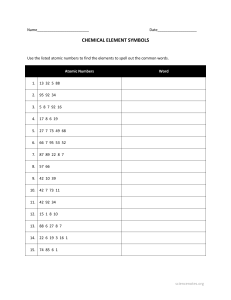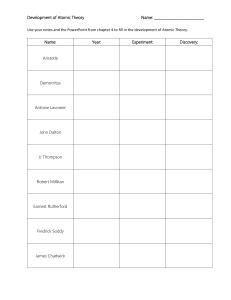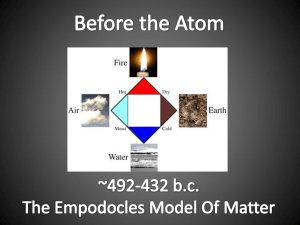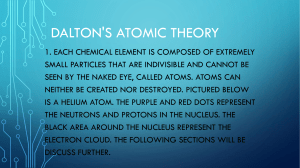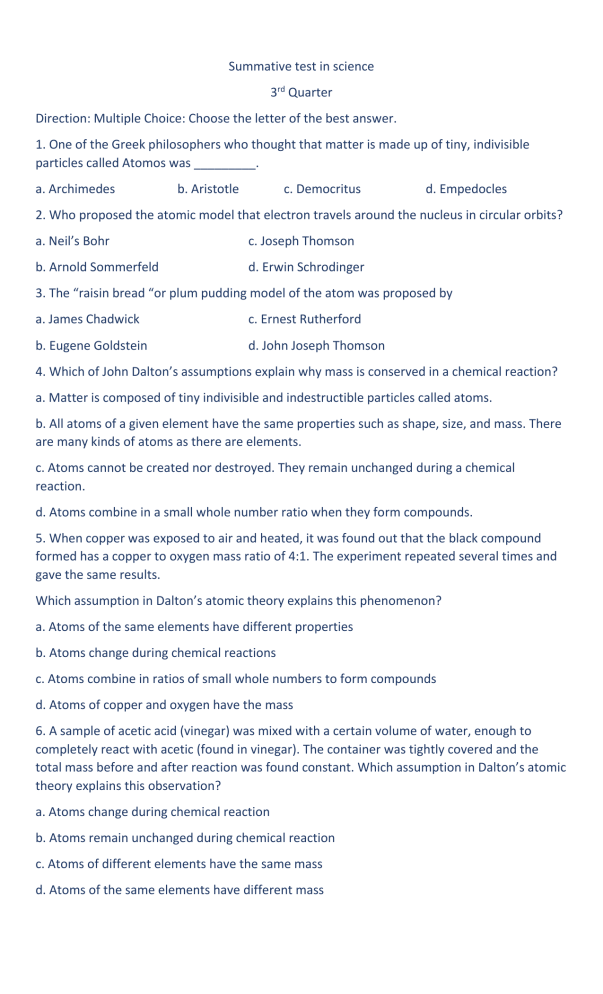
Summative test in science 3rd Quarter Direction: Multiple Choice: Choose the letter of the best answer. 1. One of the Greek philosophers who thought that matter is made up of tiny, indivisible particles called Atomos was _________. a. Archimedes b. Aristotle c. Democritus d. Empedocles 2. Who proposed the atomic model that electron travels around the nucleus in circular orbits? a. Neil’s Bohr c. Joseph Thomson b. Arnold Sommerfeld d. Erwin Schrodinger 3. The “raisin bread “or plum pudding model of the atom was proposed by a. James Chadwick c. Ernest Rutherford b. Eugene Goldstein d. John Joseph Thomson 4. Which of John Dalton’s assumptions explain why mass is conserved in a chemical reaction? a. Matter is composed of tiny indivisible and indestructible particles called atoms. b. All atoms of a given element have the same properties such as shape, size, and mass. There are many kinds of atoms as there are elements. c. Atoms cannot be created nor destroyed. They remain unchanged during a chemical reaction. d. Atoms combine in a small whole number ratio when they form compounds. 5. When copper was exposed to air and heated, it was found out that the black compound formed has a copper to oxygen mass ratio of 4:1. The experiment repeated several times and gave the same results. Which assumption in Dalton’s atomic theory explains this phenomenon? a. Atoms of the same elements have different properties b. Atoms change during chemical reactions c. Atoms combine in ratios of small whole numbers to form compounds d. Atoms of copper and oxygen have the mass 6. A sample of acetic acid (vinegar) was mixed with a certain volume of water, enough to completely react with acetic (found in vinegar). The container was tightly covered and the total mass before and after reaction was found constant. Which assumption in Dalton’s atomic theory explains this observation? a. Atoms change during chemical reaction b. Atoms remain unchanged during chemical reaction c. Atoms of different elements have the same mass d. Atoms of the same elements have different mass 7. How is Dalton’s atomic model different from Thomson’s model? a. Dalton’s atomic model is sphere and tiny while Thompson atomic model is oval. b. Dalton’s atomic model is oval while Thompson atomic model is sphere and tiny. c. Dalton’s atomic model is empty sphere while Thomson’s atomic model is round embedded with negatively charged. d. Dalton’s atomic model round embedded with positively charged while Thomson’s atomic model is empty sphere. 8. How is Dalton’s atomic theory model similar to Thompson atomic model? a. Dalton’s atomic model is sphere and tiny while Thompson atomic model is sphere/round and tiny. b. Dalton’s atomic model is oval while Thompson atomic model is sphere and tiny. c. Dalton’s atomic model is empty sphere while Thomson’s atomic model is round embedded with negatively charged. d. Dalton’s atomic model round embedded with positively charged while Thomson’s atomic model is empty sphere. 9.All of the following statements about cathode rays are true EXCEPT? a. Cathode rays are charge particles. b. Cathode rays flow from negative to positive electrodes. c. The charge of cathode rays can change from negative to positive. d. Cathode rays possess mass and momentum. 10.What is the importance of the cathode ray tube in the study of atom? a. Cathode ray tube lead to the discovery of protons. b. Cathode ray tube lead to the discovery of electrons. c. Cathode ray tube lead to the discovery of the canal ray. d. Cathode ray tube lead to the discovery of X-ray. 11.Which of the following statements best describes the properties of cathode ray? a. Cathode rays consist of negatively charged particles. b. Cathode rays consist of positively charged particles. c. Cathode rays travel with a low speed. d. Cathode rays travel in a curve line. 12.How did cathode ray tube experiment help in the study of the atom? a. The path of the cathode ray was deflected downward towards the positive plate that led to the discovery of the electrons. b. The path of the cathode ray was deflected upward towards the negative plate that led to the discovery of the electrons. c. The path of the cathode ray was deflected straight towards the positive plate that led to the discovery of the electrons. d. The path of the cathode ray was deflected straight towards the negative plate that led to the discovery of the electrons. 13.What has been proven when the path of the cathode ray was deflected upward towards the negative plate? a. It has proven that the discovered particle is positively charged. b. It has proven that the discovered particle is negatively charged. c. It has proven that the discovered particle is neutrally charged. d. It has proven that the discovered particle has a charge that cannot be detected. 14.What did the alpha scattering experiment reveal? a. The atom is made up of very small, massive, and positively charged nucleus. b. The atom consists of negative charges embedded in sphere of positive charges. c. The electrons are negatively charged particles. d. The electrons are in the nucleus. 15.Rutherford’s experiment made use of ______ as target. c. Alpha particles c. Gold foil d. Detecting Screen d. All of the above 16. Which of the following is the correct arrangement of names according to their contribution in the development of the periodic table? I. John Newlands III. Henry Moseley II. Dmitri Mendeleev IV. Johann Dobereiner A. I, II, III, IV B. II, III, I, IV C. III, II, I, IV D. IV, I, II, III 17. Who among the following scientists had a similar arrangement of elements as that of Mendeleev? A. Lothar Meyer C. Alexander Chancourtois B. Henry Moseley D. John Dalton 18. Shown below are the scientists involved in the development of the periodic table and their contribution: Which of the following does not correctly match? 19. Who among the following scientists arranged elements in such a way that elements found in the same column have similar properties, and left gaps in the periodic table that were filled when new elements were later discovered? A. Dobereiner C. Mendeleev B. Newlands D. Moseley 20. Which of the following does not correctly express the importance of the arrangement of the elements in the modern periodic table? A. It is easy to locate the elements since they are arranged according to increasing atomic number. B. Elements with similar properties are found in the same column for representative elements. C. All basic information about each element is easily found. D. The arrangement allows us to study systematically the way properties vary with the element’s position in the periodic table. 21. Elements found in groups have similarity in properties. This was possible when elements are arranged according to increasing _____. A. atomic mass B. atomic number C. group number D. period number 22. How does the arrangement of the periodic table differ from the earlier arrangement of elements? A. Elements in the modern periodic table are arranged according to increasing atomic number. B. Elements in the modern periodic table are arranged according to increasing atomic mass. C. Elements in the modern periodic table are arranged according to increasing mass number. D. Elements in the modern periodic table are arranged according to increasing physical properties. 23. What is the relevance of knowing the development of the periodic table? A. It can help in identifying properties of elements. B. It can help in understanding the arrangement of elements. C. It can help in identifying unknown elements based on its properties D. All of the above statements are true. 24. Which of the following pairs of elements belong to the same group and have similar properties? A. Copper and cobalt C. Fluorine and Chlorine B. Sodium and magnesium D. Sulfur and Phosphorus 25. Which of the following elements belong to the same group? A. Calcium, magnesium, beryllium B. Sodium, aluminum, magnesium C. Iron, copper, zinc D. Helium, hydrogen, neon 26. Which of these elements have similar chemical properties? uI. argon II. Lithium III. sodium A. I and II C. III and IV B. II and III D. I and IV IV. phosphorus 27. Suppose an element is needed for an experiment. It should be a highly reactive metal. From which group or family of elements should you choose? A. Alkali Metal B. Alkaline Earth Metals C. Halogens D. Noble Gases 28. A certain nonmetal is nonreactive under normal conditions. In which group does this element belong? A. Alkali Metal C. Halogens B. Alkaline Earth Metals D. Noble Gases 29.Which of the following is a halogen? A. Potassium B. Beryllium C. Iodine D. Carbon 30.Which of the following describes the basis of the modern periodic law? A. It is due to repeating similarity of properties of elements as you go from one period to another when elements are arranged in increasing atomic number. B. It is due to repeating similarity of properties of elements as you go from one group to another when elements are arranged in increasing atomic number. C. It is due to repeating similarity of properties of elements as you go from one group to another when elements are arranged in increasing atomic mass. D. It is due to repeating similarity of properties of elements as you go from one period to another when elements are arranged in increasing atomic mass.
